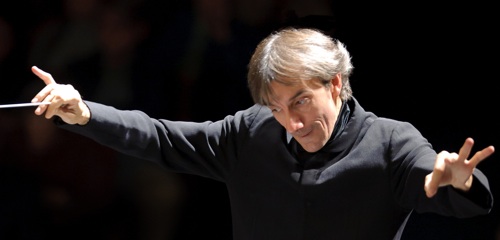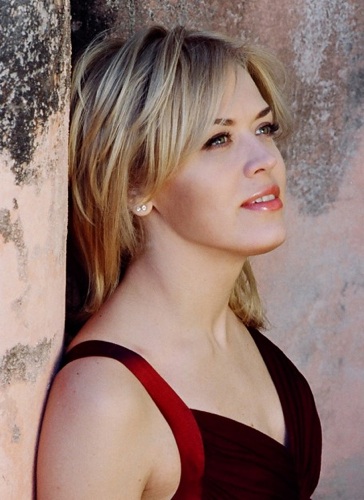Russians!
Bruno Ferrandis conducted the Santa Rosa Symphony last Saturday with flamboyant gestures and exacting tempi, braving an all-Russian concert. This was the culmination of their first season in the blond magnificence of Weill Hall, recently built on the grounds of Sonoma State, and the hall’s wooden vibrancy may have factored in the success of the program. They began with the Prelude to Khovanshchina, composed by Modest Mussorgsky at the end of a short and alcoholic life. As he had written the score for piano, but only sketched in the orchestra parts, his drinking comrade, composer Rimsky-Korsakov, did a lovely orchestration that was colorful and piquant in tone, perhaps too much so. Shostakovich was later moved to re-orchestrate it in more muted colors, better fitting Mussorgsky’s choices, and that is what we heard.
Rising cadences, “ting” of triangle and high violin glitter gave the feeling of stars slowly paling into dawn. As the day bloomed the strings turned lush, adding stout motifs with Russian curlicues. Then slow hammered tubular church bells and deeply bowed bass notes built a backdrop for sweetly Slavic modal. This loving piece by a troubled man admitted us into a world of simple scales and complex moods.
The star of the evening, Russian-born pianist Olga Kern, came onstage in a tightly corseted backless red gown, and I’m sure others wondered how she could look so good yet play so fiercely. The winner of the 2001 Van Cliburn Competition and highly regarded around the world, Kern brought great forcefulness to Rachmaninoff’s Piano Concerto No. 2. Written during Rachmaninoff’s recovery from depression and “composer’s block,” with the aid of psychiatrist Nicolai Dahl, this concerto galvanized the modern world with its brooding intensity, inward focus and distinctly Russian brand of romanticism.
It opened with a soft C chord and responding low note, repeated and gradually building to thunder, evoking the transmutation of inner demons into a raging joy of pounded fists.
But in Saturday’s performance there was a small fly in the ointment: either the performer or the sonic liveliness of the hall was creating a sharp edge to the piano. That hall, so kind to strings, seemed to make the “six foot six inch tall scowl,” as Stravinsky described  Rachmaninoff, sound like teen angst. Either that or, despite Kern’s huge technical prowess, she was employing a chiseled technique ill suited to the emotional truths of Rachmaninoff, with strokes that went from crisp to bold without exposing his inner terrain.
Rachmaninoff, sound like teen angst. Either that or, despite Kern’s huge technical prowess, she was employing a chiseled technique ill suited to the emotional truths of Rachmaninoff, with strokes that went from crisp to bold without exposing his inner terrain.
But then the strings roared in to save the day, a lush rejoinder that grabbed the listener on every level.
Ferrandis, reminiscent of Rachmaninoff with his gaunt frame and large expressive hands, combined liberal strokes with an exacting nature. He brought the bacon home in the luminous Adagio, and orchestra and piano joined together for some real holiday pay in the Scherzando… and this time it was supposed to glitter.
And more Russians!
Nearly every person rose for cheers and ovation, before settling in for another powerhouse, Dmitri Shostakovich’s bitter Symphony No. 10. The fine musicians turned in a riveting performance, with all one could want for in search of true Russian soul. Huge unity in the strings, brilliant viola passages, a flute solo with meaty breadth at the bottom of its range, great horn work, and floating above it all was the cool loneliness of a clarinet.
Shostakovich chose basses to intone his opening, but unlike the mystery and power of Brahms’ paeans to nature, in this work his gestures were haunting and fearful. The upper strings entered with compressed and minimal themes, then built to the bombast of man-made emporiums, as if concrete and diesel were answering Mussorgsky’s promise of dawn and Rachmaninoff’s yearning heart.
Written after Stalin’s death, this was Shostakovich at his least coded: bitter, fearful, elegiac and brutal. Unlike Beethoven’s Missa Solemnis, which the SF Symphony did so brilliantly last week, in Shostakovich’s Russia nobody seems to get to Heaven. The State just shoots them.
The Santa Rosa Symphony has announced their 2013 – 2014 season, an impressive seven-concert series titled “Encores and Debuts.” More information is available at www.santarosasymphony.org.
—Adam Broner
Photo top, of pianist Olga Kern, photo by Fernando Baez; bottom, of conductor Bruno Ferrandis, photo courtesy of Susan and Neal Silverman.
